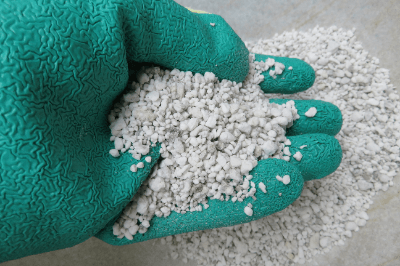What Is Perlite?
 Perlite is an artificial foam made from obsidian, perlite, and other rocks that have been treated at high temperatures to form a granular material.
Perlite is an artificial foam made from obsidian, perlite, and other rocks that have been treated at high temperatures to form a granular material.
It is used for horticultural, industrial, and building materials. Perlite is made by rapidly evaporating the water contained in rocks to form a porous structure and is extremely lightweight.
It is mainly used for horticultural purposes, but it is also used for industrial and building materials due to its excellent heat insulation, heat retention, and fire resistance properties due to its porous structure. The microstructure of steel obtained by slow cooling of carbon steel or alloy steel from the austenitic state is also called perlite, but this article will discuss perlite, which is a rock foam.
Uses of Perlite
The uses of perlite can be classified into three main categories.
1. Horticultural Use
Perlite is used as a culture medium and potting stone. It is widely used as a soil conditioner because it is very lightweight and has various properties. When using perlite, it is recommended to mix about 10~20% of perlite to the total soil.
2. Filter Aid
Perlite came into use in the 1950s as an alternative to diatomaceous earth filtration aids. It is chemically very stable and is used as a catalyst and carrier. It is also often used to separate solids from gases.
3. Building Materials, Heat Insulating Materials, Etc.
In recent years, perlite has found increasing use in insulation and filler materials rather than as a filtration aid. As a porous material, it is lightweight, insulating, fireproof, and soundproof. For this reason, it is often used in siding boards for wall materials.
As a heat insulator, perlite is also used on a large scale in the refrigerated and frozen storage of liquefied natural gas (LNG) storage tanks and ships. In addition, perlite can be added to cement to produce a light, strong mortar. In high-rise condominiums and buildings, the addition of perlite has made it possible to produce lightweight concrete that maintains its strength, reducing the costs of transportation, production, and raw materials.
Other applications for perlite include additives for resin products, dental applications, seal materials, matting agents for paints, silicon rubber, and paper manufacturing.
Properties of Perlite
Two types of perlite gemstones are used: perlite and obsidian. Each has its characteristics and is used in a way that takes advantage of those characteristics.
1. Nacreous Perlite
Nacreous perlite is a porous particle obtained by processing nacreous rock at high temperatures. Perlite has a high water content, resulting in a spongy, porous structure. Because of its excellent water retention and permeability, it is used in soils with poor water holding capacity.
2. Obsidian Perlite
Obsidian perlite is obtained by heating black-green obsidian at high temperatures to evaporate water. Since obsidian perlite contains less water than perlite, the heat treatment produces numerous microscopic pores. These microscopic pores are difficult for water to penetrate and therefore have excellent drainage properties. It also possesses ion-exchange properties that change it into mineral water, which has the effect of preventing root rot. Because of these characteristics, perlite is often used in soils with poor drainage.
Other Information on Perlite
1. The Difference Between Perlite and Zeolite
Perlite is made by heat-treating glassy volcanic rock, so its main components are silicon dioxide, aluminum oxide, iron oxide, potassium oxide, and sodium oxide, which are found in rocks and ores.
Zeolite, on the other hand, is an aluminosilicate, and its main constituents are silicon, aluminum, and oxygen. Although the elemental composition is similar to that of perlite, there are differences in molecular structure and properties.
The differences between perlite and zeolite are compared in horticultural applications. For example, perlite is used to regulate soil moisture content. If the soil drains well and dries out quickly, perlite is used for its water retention properties. If the soil drains poorly and plant roots rot, obsidian perlite is used for its drainage properties.
Zeolite, on the other hand, is used to provide aeration and nutrients to the soil. Because it is porous and has moderate air permeability, mixing it with soil improves plant growth by supplying sufficient oxygen to plant roots. In addition, the amount of fertilizer can be reduced because the minerals leached from zeolite become nutrients for plants.
2. Dangers of Perlite
Since perlite is originally a rock, it is not particularly hazardous when used normally. Inhaling large amounts of perlite dust through the nose or mouth can lead to pneumoconiosis. Pneumoconiosis is a disease caused by the accumulation of dust in the respiratory system. There are no subjective symptoms in the early stages of the disease, but over time, symptoms such as cough, phlegm, shortness of breath, and difficulty breathing may appear.